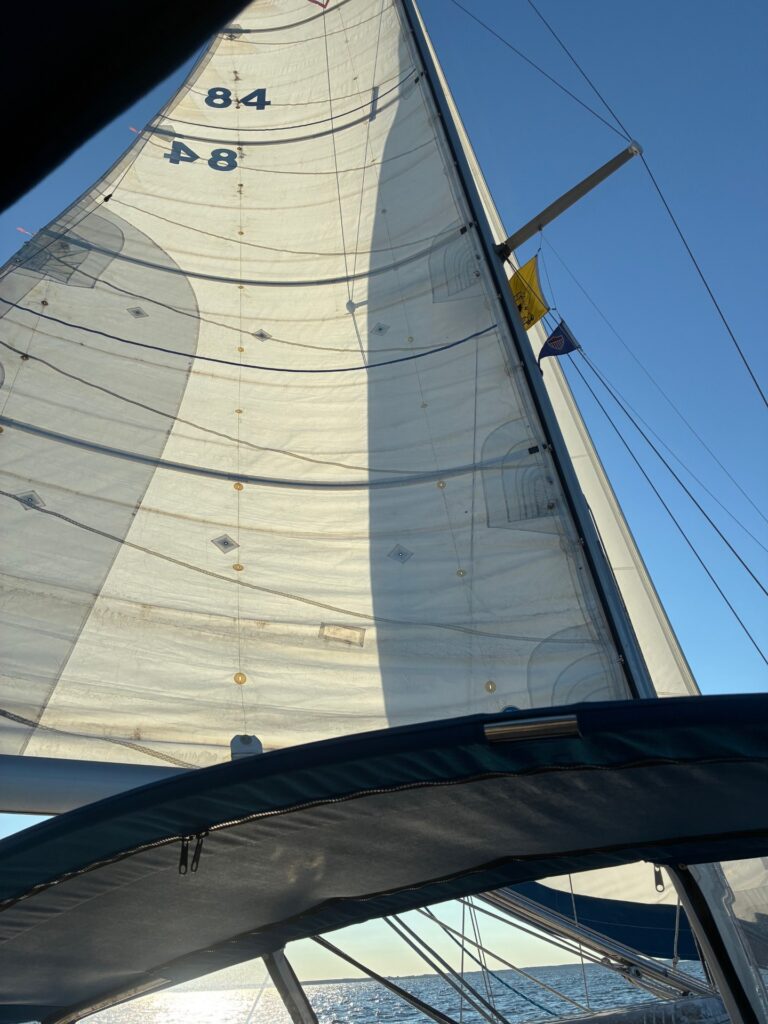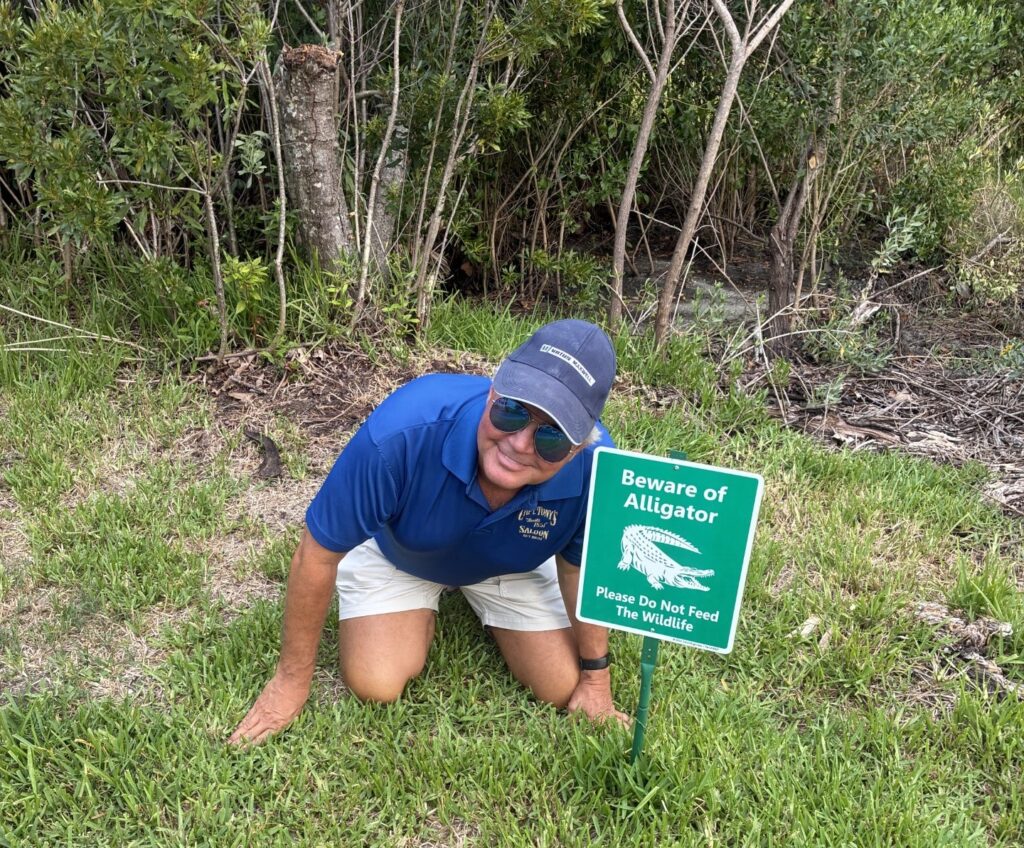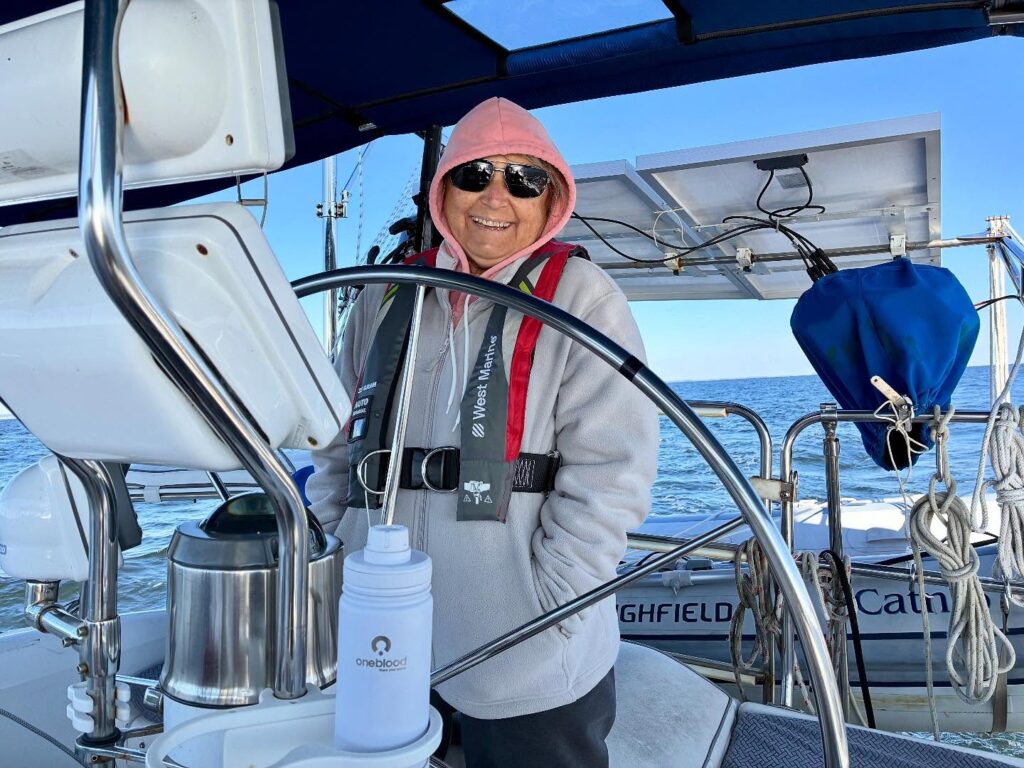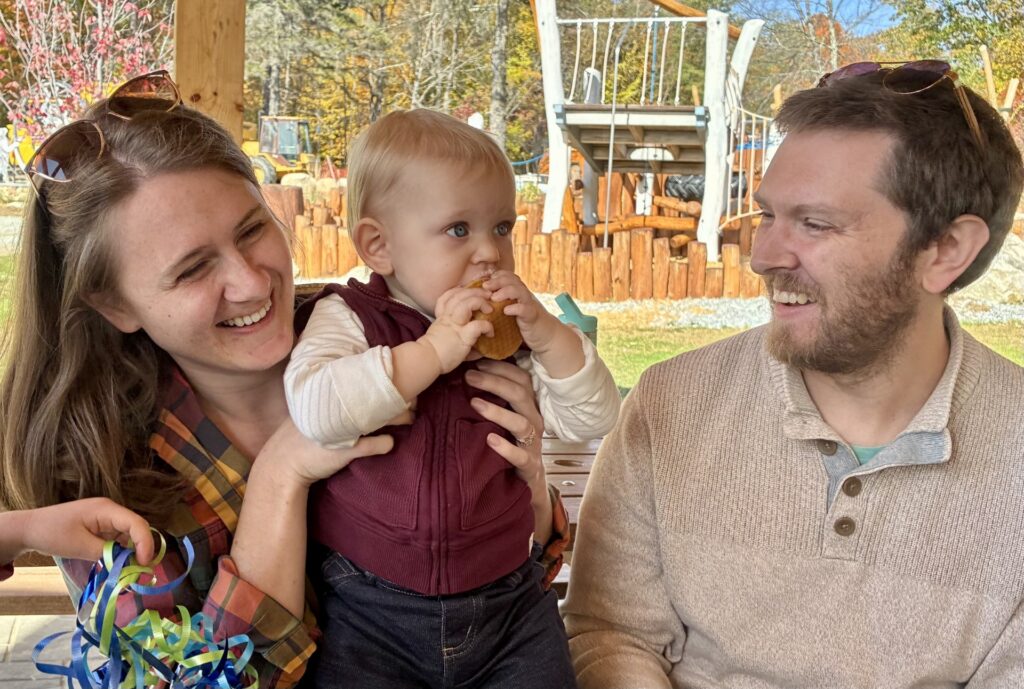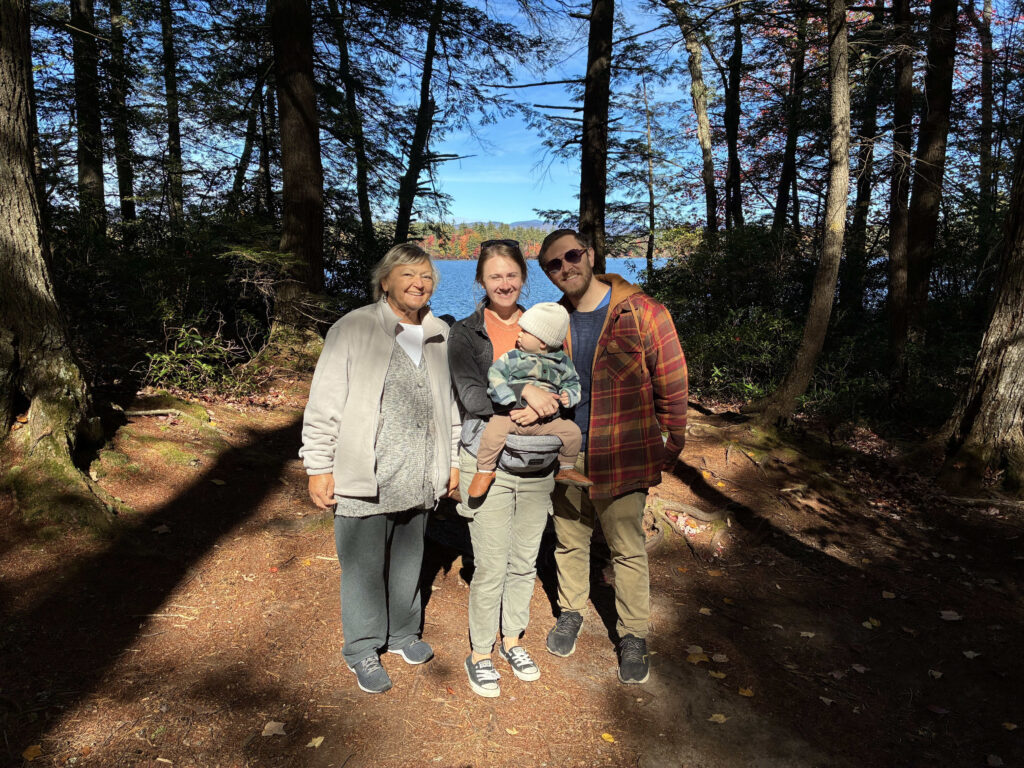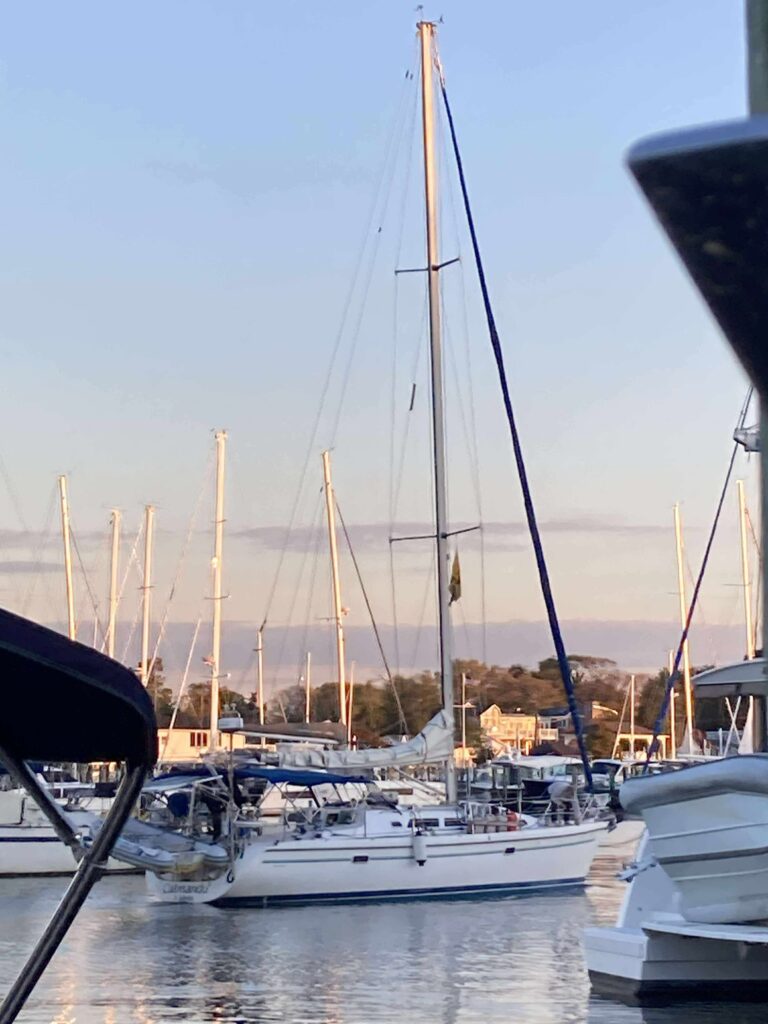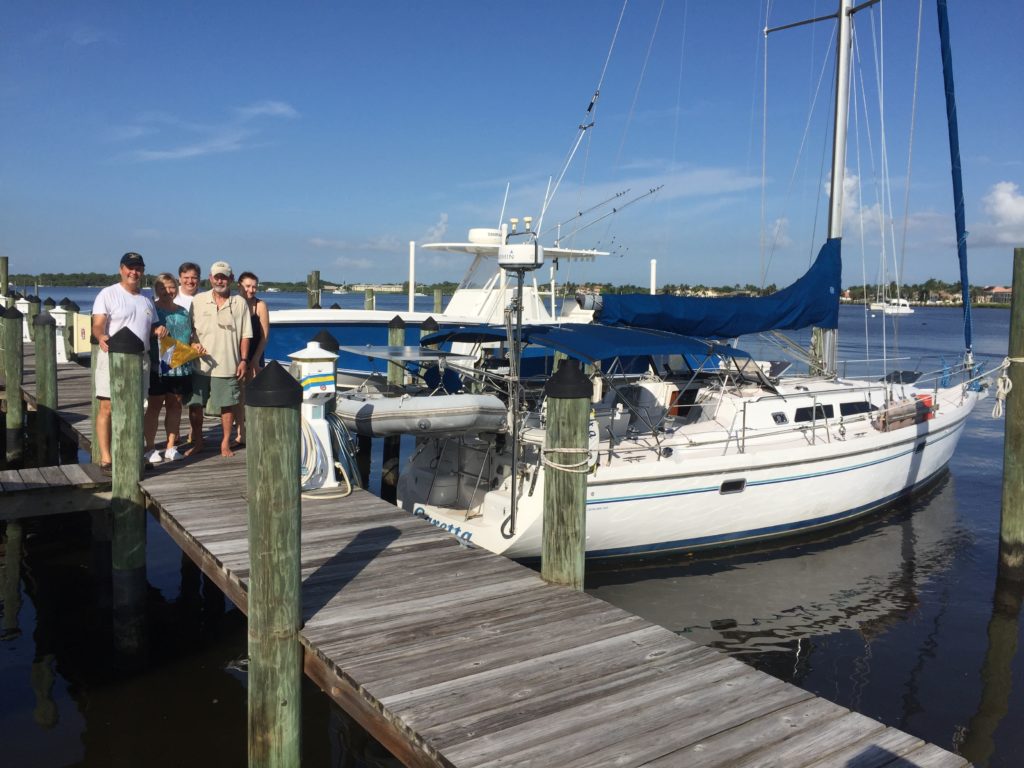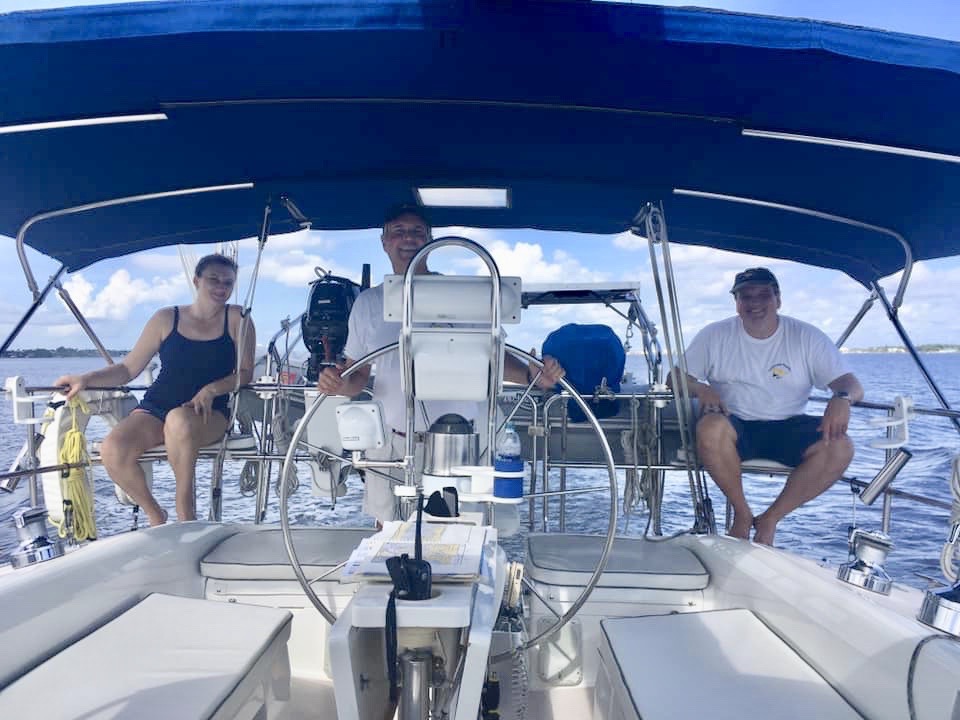Right of way: Nautical legal principle that establishes whether or not a particular boat
has the right to ram or the duty to dodge in any given marine encounter.
“Ahoy” is the first in a series of four-letter words commonly exchanged
by skippers as their boats approach one another.
— Sailing, by H. Beard and R. McKie“Schmidt!”
— Phil Decker, S/V Catmandu
Leaving Annapolis
As we made our way out of the crowded fairway of Back Creek, Phil noticed a large bird flying solo over the harbor. “Could that be a bald eagle?” he asked.
“No, I think it’s too small,” I said. Just then, it landed on the green channel marker next to us, its large white head gleaming in the early sunshine. It perched there, looking like a sculpture – like the symbol of freedom it is, and I admitted I was wrong. “Oh, yes,” I said, “That’s an eagle.”
“A good omen,” said Phil.

We turned into the wind and raised the mainsail. So it began, the best day of sailing either of us can remember. We were headed to warmer weather, but first, a clear cold day with perfect wind and sea conditions made us wish we could stay longer and sail around the Chesapeake. We unfurled the jib and headed southeast with a 10-knot wind from the northwest. Within ten minutes, the engine was silent and Catmandu was flying over the water, reaching speeds of 8.6 knots in favorable current. We were thrilled.
When we reached Solomon’s Island, we pulled into the mooring field and searched for our reserved mooring ball. When we found it, Phil rushed up to the bow and I steered Catmandu so Phil could reach the pennant. He got it, first try, and we were celebrating in the cockpit moments later. A blue sailboat with red canvas (S/V Red Shift) came in next and maneuvered around the other sailboats in the mooring field. A woman stood on the bow and shouted into the wind:
“So many sailboats! I have found my people!”
We laughed and waved. Phil and I have felt this way in Annapolis, in Marathon, and recently on the ICW. The Intracoastal Waterway is now crowded with sailboats heading south, politely asking each other on the VHF if it’s okay to pass. We have found our people. (Now we follow Red Shift on No Foreign Land, an app that tracks the locations and voyages of member boats, and they follow us.)
Phil was up at dawn and checked the temperature in the cabin. It was a chilly 55 degrees. We bundled up and motored out into a rolly Chesapeake, heading to Deltaville. We anticipated a 10-hour day, but with calm seas, a sail up, and a clean bottom, we arrived in 8-1/2. We had been to the Regatta Point Marina last August, and the dockmaster Don remembered us. Being plugged in to the dock meant we had heat overnight. The next morning, Don helped us out of our slip. It was a tight turn into the fairway, and we ended up with our anchor clanging into a piling behind the boat in the next slip. With me pushing against the piling, and Don’s help at the dock, Phil got the boat straightened out and we were on our way.
In mid-afternoon, just barely into the Norfolk inlet, Phil spotted a dolphin crossing in front of Catmandu. I looked up to see two more. We had not seen dolphins this far north before. As we made a right turn toward our anchorage at Fort Monroe, a majestic wooden schooner named Godspeed appeared on our starboard side. They called on VHF asking if they could cross our bow and pass port-to-port. We slowed down and let the stately sailing ship pass.
Getting Through Norfolk
Catmandu spent a quiet, cold night anchored at Fort Monroe / Mill Creek (in the company of 19 other boats) and left very early to start into Norfolk Harbor. As we motored into the busy channel, a gigantic cargo ship bore down on us from the port side, and an equally enormous ship had just crossed our bow. The cargo ship gave five blasts of its horn (the “danger” signal) and just as I asked, “Was that for us?”, they radioed us by name, saying we should “stand clear.” Those ships can take up to two miles to come to a stop, and do not turn on a dime. We were only too happy to stand clear and let them pass.
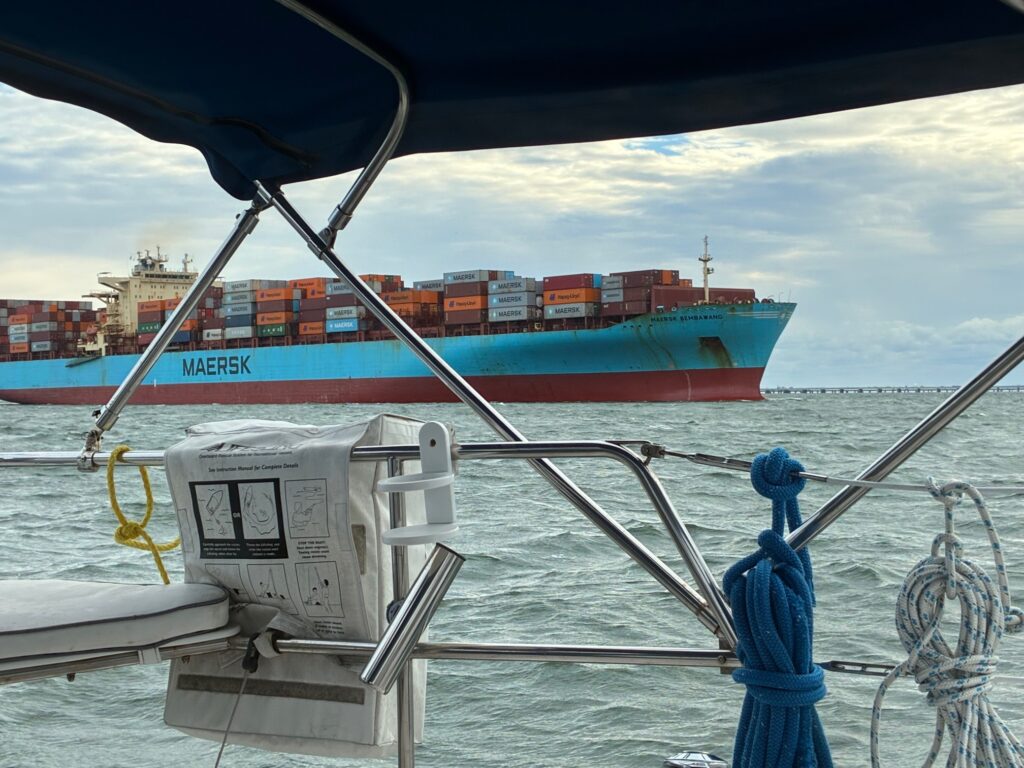
We pulled into a line of boats heading west into the port of Norfolk, hearing the constant scoldings on VHF telling captains to “Slow down! This is a no-wake zone.” Behind us, a huge Navy ship was gaining on us, forcing us to slide to the right. Phil was at the wheel, watching the port side of the channel and I was watching the encroaching Navy vessel.
“Schmidt!” Phil yelled, and suddenly our boat veered to port. I looked at Phil to see if he was okay and immediately saw the problem: a fuel barge the size of a football field was being pushed into the right side of our boat, barely 200 feet away and closing fast. The tug pushing it was not about to change course (sailboats be damned) and Phil spun Catmandu in a tight circle to the left to avoid being hit. The tugboat, the Potomac, did not call us, did not veer off, and continued as if we were not there. Only the quick action of Phil behind the wheel kept us from being pulverized.
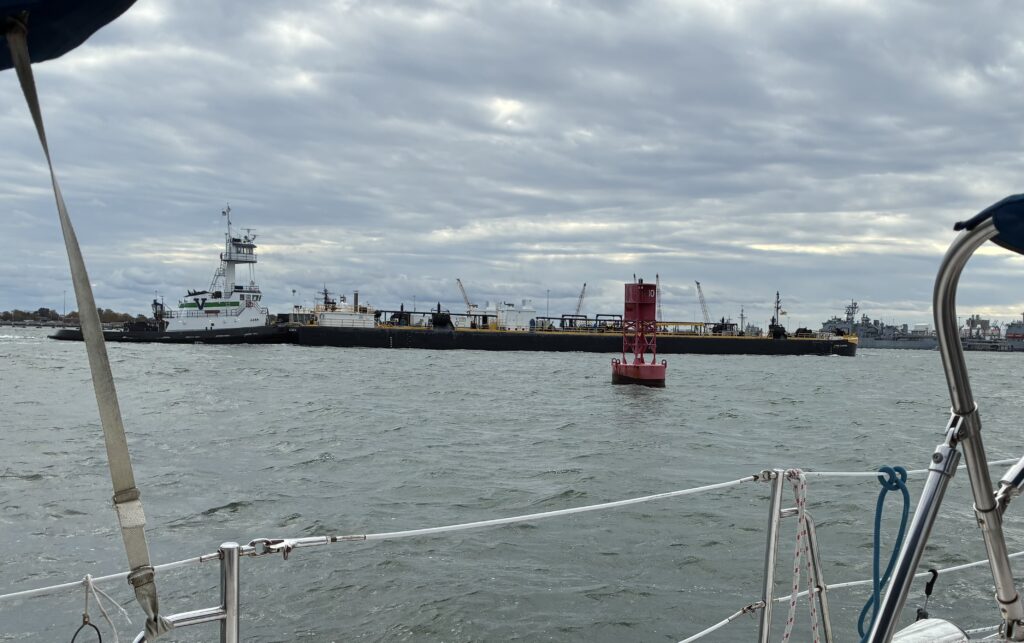
“Schmidt?” I said, after we regained our course and our composure.
“Well, it’s not what I wanted to say,” he admitted.
“Did you get the name of the murder barge?” I asked, coining a phrase that felt appropriate.
“I got the name of the tug – Potomac,” he said. “It will go in the log.”
On to Great Bridge
At the southern end of the busy Norfolk port is a lock and bridge that lead into the ICW. The bridge has been under construction for some time, and currently opens only on the even hours between 8 a.m. and 4 p.m. The lock, a half mile away, opens in concert with the bridge. In order to make the 2 p.m. bridge, we had to be at the lock by 12:30.
Avoiding cargo ships and murder barges proved difficult but we made our way with other boats our size and soon put most of the busy Monday morning traffic behind us. Ahead of us, we saw a large Navy vessel with “29” painted on the side. There were around five tugboats hanging around and we attempted to pass the warship to the right. A sailboat in front of us slowed down and so did we. Not sure what to do, we circled behind the sailboat and waited for the tugs to do something. Several other sailboats caught up and we paraded in a circle, looking like a slow regatta. Soon no one could fit through the channel.
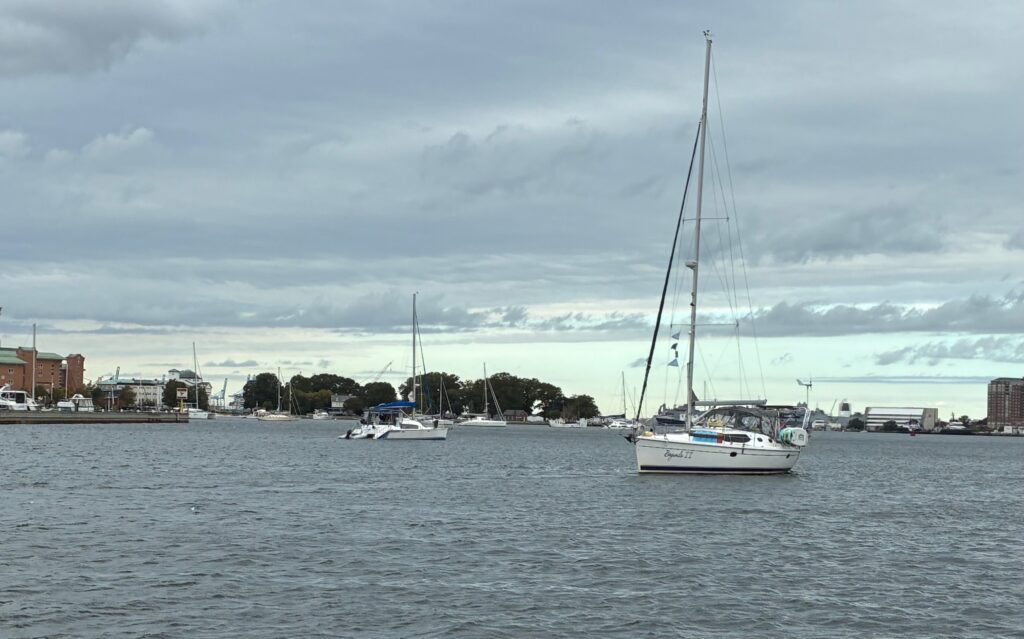
Finally, the radio squawked. “All vessels, all vessels, Warship 29!”
Warship 29 is the USS Beloit, a littoral combat ship. “We will be exiting the slip and occupying the entire turning basin. All vessels are advised to stand clear.” Since we were circling in what appeared to be the turning basin, we wondered where we were supposed to go. Soon it was made clear that we were expected to backtrack and tuck out of the way while the behemoth backed slowly into the channel, aided by tugs, and turn completely around. The sailboat parade headed back where they had come from and waited.

A full thirty minutes later, we were still waiting for the “all clear” when the boat in front proceeded to enter the basin again. We followed, afraid the long delay would make us miss the lock and bridge. The Navy ship was nearly turned around when we slipped past it and headed for the Gilmerton Bridge, along with our sailboat parade. After the bridge, most of the other boats stayed to the right to enter the Dismal Swamp. Our draft, at five and a half feet, is too deep for that route. Besides, who wants to enter the “Dismal Swamp”? The name alone steers us elsewhere.
We kept going and entered the Great Bridge lock on schedule at 12:30 p.m. We were the third boat to pull in, but we waited over an hour for five more boats to enter. As we waited, a graceful little baby deer ran through the lawn next to the lock and bounded into the forest beyond. It was too quick for a picture. It was adorable.

Gales were predicted for the next few nights, and we had no desire to anchor out or cross Albemarle Sound in that kind of wind. A gale is defined as sustained winds between 34 and 47 knots. We docked easily at Atlantic Yacht Basin and spent three rainy days and nights in our cozy boat, tied securely to the sturdy dock, far removed from megaships, murder barges and the U.S. Navy.

